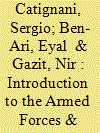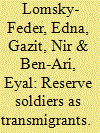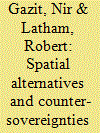|
|
|
Sort Order |
|
|
|
Items / Page
|
|
|
|
|
|
|
| Srl | Item |
| 1 |
ID:
181153


|
|
|
|
|
| Summary/Abstract |
This Armed Forces & Society forum is dedicated to exploring recent trends in the characteristics of military reserves and of the changing character of reserve forces within the armed forces within the military, the civilian sphere, and in between them. To bring new and critical perspectives to the study of reserve forces and civil–military relations, this introduction and the five articles that follow draw on two organizing conceptual models: The first portrays reservists as transmigrants and focuses on the plural membership of reservists in the military and in civilian society and the “travel” between them. The second model focuses on the multiple formal and informal compacts (contracts, agreements, or pacts) between reservists and the military.
|
|
|
|
|
|
|
|
|
|
|
|
|
|
|
|
| 2 |
ID:
181154


|
|
|
|
|
| Summary/Abstract |
This article reexamines and develops the analytical metaphor of “Reserve Soldiers as Transmigrants” in three directions. First, we advance the notion of transmigration by linking it to the explicit and implicit “contracts” or agreements struck between the military and individuals and groups within and outside of it. Second, we show that the “management” model of reserve forces is not just an administrative matter but that “negotiating” with reservists involves wider issues that include managing identity, commitment, and the meaning attached to military service. Third, we examine the institutional and political meaning of the reserves at the macro sociological level. The juxtaposition and interplay of two models—transmigration and multiple contracts—allows us to introduce structural elements into the movement of soldiers between the military and civilian society, and add a dynamic dimension to the contents of the implicit contracts that organize reservists’ relations with the state and military.
|
|
|
|
|
|
|
|
|
|
|
|
|
|
|
|
| 3 |
ID:
082696


|
|
|
|
|
| Publication |
2008.
|
| Summary/Abstract |
This article suggests a new perspective for examining the particular social and organizational characteristics of military reserves forces and the special experiences of serving in the reserves. To illustrate the unique social position of reservists, the authors develop a theoretical model that likens them to transmigrants. Accordingly, the authors suggest that society may benefit from looking at reserves both as sorts of social and organizational hybrids or amalgams-they are soldiers and civilians, they are outside yet inside the military system, and are invested in both spheres-and as continual migrants journeying between military and civilian spheres. The authors end by suggesting that it may be fruitful to study three segments of the military, each of which has its own dynamics: regulars, conscripts, and reserves. This differentiation allows society to examine different patterns of motivation, cohesion, political commitment and awareness, and long-term considerations that characterize each segment
|
|
|
|
|
|
|
|
|
|
|
|
|
|
|
|
| 4 |
ID:
130987


|
|
|
|
|
| Publication |
2014.
|
| Summary/Abstract |
The securitization of the spaces of Israeli-Palestinian interaction, from checkpoints to the West Bank Separation Wall, continues to intensify and receive attention from journalists, scholars, and activists. Understandably, the focus is on the negative consequences of existing spatial configurations. Receiving far less attention is the development of alternative spatial formations which might advance forms of "desecuritization," especially in those spaces that are crucial hinges of Israeli-Palestinian interaction (Jerusalem and other mixed cities, the Wall, the Green Line, roads). This article explores whether alternative ways of using, organizing, experiencing, and coexisting in space-especially at the micro level-hold out promise for helping to reframe significant dimensions of Israeli-Palestinian interaction. It seeks to better understand whether disjointed forms of sovereignty that appear-or disappear-across the occupation can be met by counter-sovereignties; whether new spatial counter-realities can be articulated through everyday life; and whether forms of agency, especially contestation, can reset understandings of, and perspectives on, spaces. A range of examples are considered within Jerusalem, mixed cities, the occupied Palestinian territories and at the border, bearing on religious sites, healthcare, gentrification, security infrastructure, popular protest, and festivals
|
|
|
|
|
|
|
|
|
|
|
|
|
|
|
|
|
|
|
|
|